Huge honking diamond alert, guys! *kazoo noise*
Sotheby’s is selling The Infinite Blue, an 11.28 carat radiant-cut fancy vivid blue diamond in a single-lot live auction in Hong Kong on October 5. It’s very pretty! And it’s been further embellished by an 18k white and pink gold setting that pairs trapeze-cut diamonds on the shoulders with a frame of pink brilliant-cut diamonds. It’s quite something:
The Infinite Blue diamond comes from South Africa’s Cullinan mine (a.k.a. the Premier Mine), a legendary mine that opened in 1902 and eventually emerged as the main source of natural blue diamonds in the world. The mine is operated by Petra Diamonds Ltd., who initially released the Infinite Blue as part of the Letlapa Tala Collection, a group of five rough blue diamonds they sold to a partnership between DeBeers and Diacore back in 2020 for $40 million. (You can see a short video featuring all five rough diamonds here.)
The Infinite Blue was the largest of the set, and according to Sotheby’s, the stone went on to be “faceted and polished with the inclusion of the number 8 in mind. Well-regarded as an embodiment of prosperity and auspiciousness in Asia, the form of the numerical digit is reminiscent to the universal symbol for infinity.” I would like to know more about how the number was worked into the cut, but I have yet to find anything specific.
The stone is a big deal because blue diamonds are crazy rare, particularly at larger sizes. We know they get their color from the element boron, but the weird thing is, boron is usually present in the earth’s crust, NOT deep in the mantle where natural diamonds are formed. So how the heck are blue diamonds coming out of there? A 2018 study led by Gemological Institute of America geologist Evan Smith has possibly cracked the case, and apparently it’s all about plate tectonics. Their paper is here (access required), but Science News has a nice little summation:
The likeliest explanation, Smith and colleagues say, is that the boron hitched a ride with a subducting ocean plate.
Boron is dissolved in seawater, which circulates through ocean seafloor and reacts with certain minerals to form a water-rich mineral called serpentinite. During a tectonic collision, an oceanic plate bearing serpentinite may subduct, or sink beneath another plate. The sinking plate then carries the serpentinite — including the boron — deep into the mantle.
So this means that blue diamonds are among the deepest diamonds formed on earth, which is pretty cool. Shame they make it all the way to the surface only to sit in some sociopathic billionaire’s safe in Dubai.
The Infinite Blue is expected to sell for between $26,000,000 - $37,000,000.
From October 3-17, Christie’s is presenting a series of auctions in New York entitled Rothschild Masterpieces, and let me just tell you: shit is BANANAS. The series includes three live auctions and one online, and will present pieces from the collection of Baron James de Rothschild, his wife Betty and their sons Baron Alphonse and Baron Gustave.
James was the Rothschild who expanded the family’s banking empire to France during the early 19th century, and he was an avid collector. His sons continued the tradition, so these sales run the gamut from Renaissance jewelry, Old Master paintings, European furniture and silver, Italian ceramics…it’s a lot. Baroque decorative arts are just a whole vibe. It’s not necessarily MY vibe, but it certainly is a lot more fun to scroll through than page after page of colorless diamonds.
So first up, there’s the Rothschild Masterpieces sale that has the super high-end stuff in it, like this early 16th century French diamond and enameled gold badge depicting Saint Michael having a great time slaying the dragon. It’s not just a regular old brooch or pendant, though, says Christie’s:
This type of badge, which could be worn as a hat-badge, would carry a political as well as personal or chivalric message. Hat-badges or pendants acted as fashion accessories as seen in portraits painted across Europe in the early to mid-16th century, and could also help identify a sitter or express their courtly status.
The fact that Michael’s body is made of diamonds leads them to speculate that this particular badge was created for a royal. The estimate is $80,000 – $120,000.
So the REALLY bananas stuff is in the second sale: Rothschild Masterpieces: The Kunstkammer. That’s where you’ll see a lot of the wild things rich people used to decorate their tables many centuries ago, so we’re talking lots of nautilus shells in gilded mounts and whatnot. Also, LOTS of Italian Renaissance maiolica, or tin-glazed pottery.
The piece above is a novelty maiolica ewer that was probably made at a workshop in Urbino, Italy around 1580-1600. It’s possible it was actually used at the table or simply kept as a decoration, but the piece takes the trippy form of a harpy-like creature with the winged body and webbed feet of a bird, a long tail and a spout terminating with the head of bearded man. Again, it’s a whole vibe. (Estimate: $6,000 – $10,000.)
One sobering fact: the provenance of this piece is listed below, and many of the other items in these auctions state something similar, adding an additional layer to their stories.
Provenance
Baron Alphonse de Rothschild (1827-1905).
Baron Édouard de Rothschild (1868-1949).
Confiscated from the above by the Einsatzstab Reichsleiter Rosenberg following the Nazi occupation of France in May 1940 (ERR no. R 4082).
Recovered by the Monuments Fine Arts and Archives Section from the Altaussee salt mines, Austria, and transferred to the Munich Central Collecting Point, 23 June 1945 (MCCP no. 391/4).
Returned to France on 9 January 1946 and restituted to the Rothschild family.
By descent to the present owners.
There’s an online Master Discoveries auction currently running at Sotheby’s New York (closing on October 6th), and it’s mostly European painting and sculpture from the 16th-19th centuries. There’s lot of delightful stuff in there — somebody’s little white dog, genre paintings like this one of a proud dentist, and this tiny little 16th century oil on copper Witches Sabbath, complete with fun monsters and an owl chomping on a sparkler. I’m also beguiled by the perfect range of expressions (and the COLOR, my god, the color) in this depiction of a Spanish wine tasting by Jean Georges Vibert. All that aside, I mainly want to take note of the above 1887 oil on canvas, entitled The Spirit of Winter (Look Here’s My Boob),1 by Paris Salon painter Pierre-Louis-Marius Poujol. It’s estimated at $20,000 - $40,000.
October 6th is also the date of the Magnificent Jewels auction at Sotheby’s Hong Kong. Alongside all the usual high-end jadeite and diamonds, it includes the incredibly extra Cartier “Amapa Panthère” bangle above, in which a pavé-set diamond panther with onyx spots and emerald eyes cradles a giant 77.48 carat cabochon rubellite. The other half of the bangle features a tiny watch nestled in a thicket of rubellite and emerald beads, and honestly, the watch annoys me. Why is that there? Who needs that? It’s stupid.
Whatever. The whole shebang is set in 18k white gold and estimated at 7,800,000 - 12,000,000 HKD or $996,000 - $1.5 million.
In case you’re wondering, rubellite sounds like it might be ruby — but it’s not, it’s actually tourmaline. It’s not as hard on the Mohs scale as ruby, but it gives you great pink-to-violet color and transparency. I always go for jewelry that looks like candy and apparently I’m not the only one, as Nico Landrigan, president of Verdura, told Jewelry Connoisseur last year that rubellite is the most popular stone in their line of “Candy” rings because it “looks like a Jolly Rancher.”
I was only going to show one of these two bracelets, but the heck with it; I love colored stones and they’re both so stinking pretty. The beautiful 1928 Cartier bracelet above is also included in the Hong Kong sale, and it’s an example of one of Cartier’s most famous jewelry styles: Tutti Frutti, which they debuted in the 1920s. Using Indian gemstones and mimicking traditional Indian jewelry style, Cartier’s designers grouped elaborately carved and cabochon stones into fantastic patterns that are a joyful riot of color. They’re still creating Tutti Frutti pieces today — these cufflinks can be had for a mere $238,000.
The platinum bracelet above is set with carved sapphires, rubies and emeralds and further embellished with emerald and sapphire beads and single-cut and old European-cut diamonds. The central diamond plaque features accents of black enamel. It’s listed as “price upon request,” so don’t even bother asking, you peasant.
I tend not to cover “Antiquities” auctions because the whole market is so shady and I don’t really feel comfortable promoting it. But I’m going to make an exception today, though, because I want to point out this Roman gold ring at Christie’s that dates to around the 3rd century A.D. It’s a great example of a fede ring, which I told you all about a while back. Fede means “faith” in Italian, and the clasped hands motif represents the joining of two hands in betrothal — a symbol that has carried through the centuries and endures today. It’s not often we get to see these early examples, though, so good stuff.
Ok, that’s it for today, friends. Oh, did you see that Freddie Mercury’s teeny tiny mustache comb sold for $186,000? And Diana’s sheep sweater for $1,143,000????? Absolute scenes, as my English friends might say.
I hope you’re all well and looking forward to the spooky season, because god knows I am. This past summer earned a hearty boot in the ass on the way out, and the autumn won’t be any better but at least we’ll have apple cider and 12-foot tall lawn skeletons and PLEASE get your vaccinations. I’ll see you in October.
M xx
I added that last part





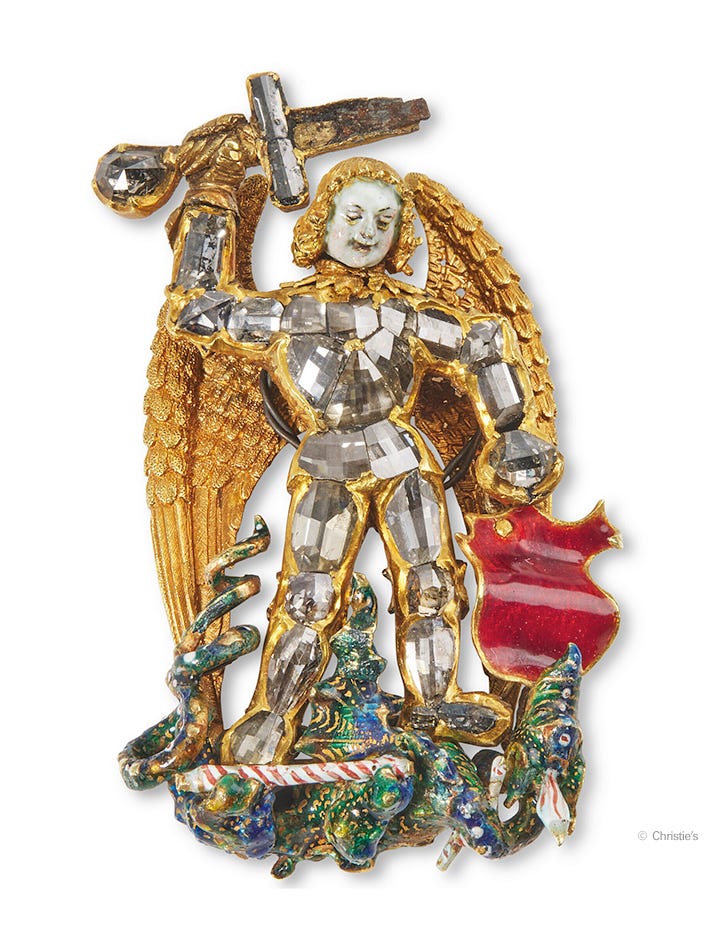
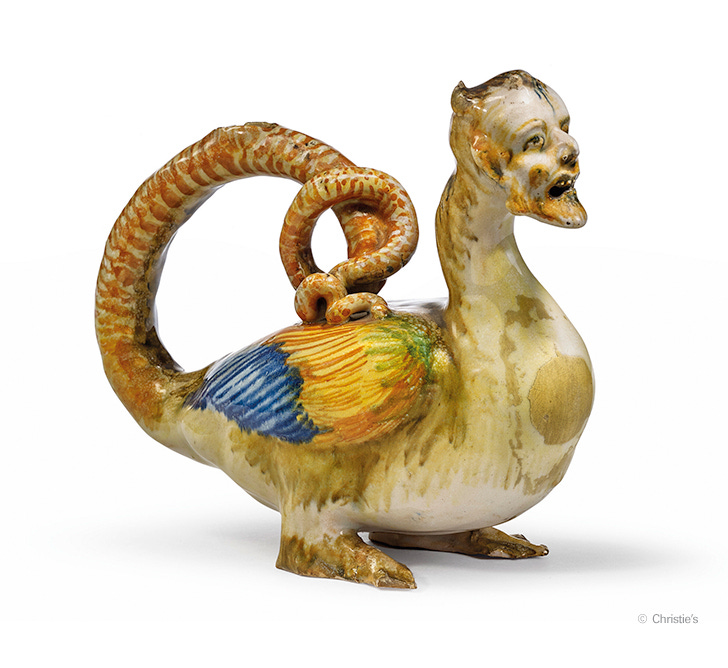
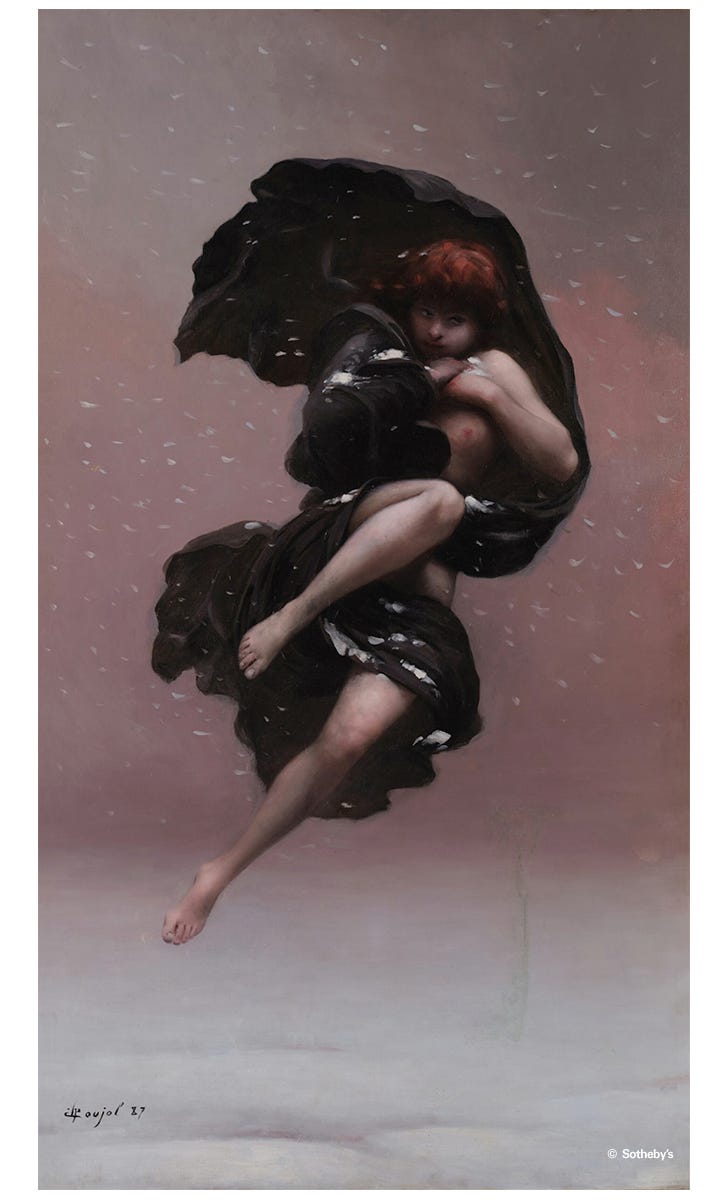
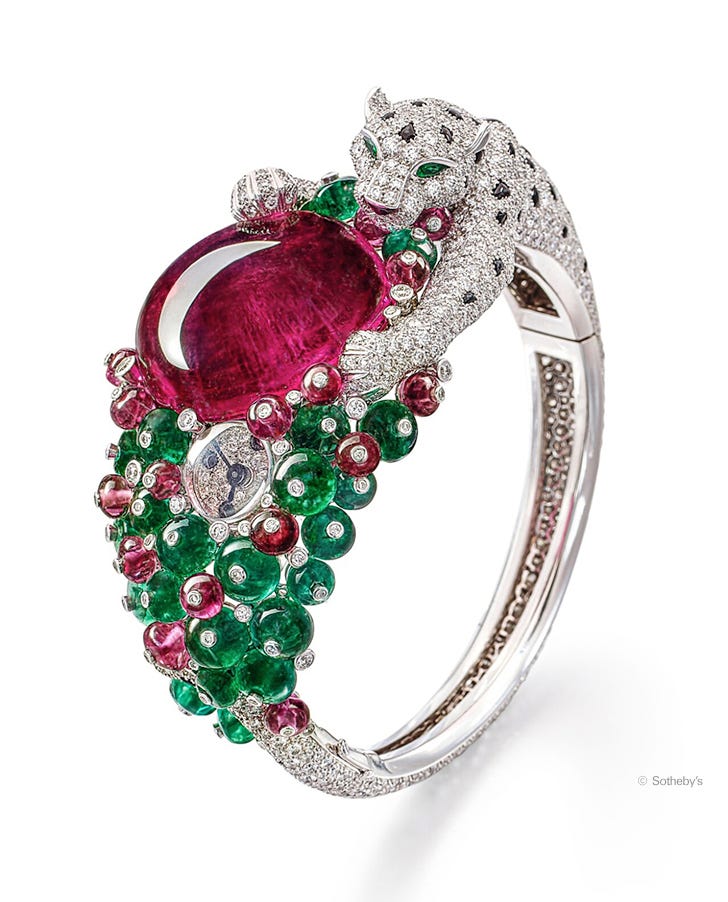
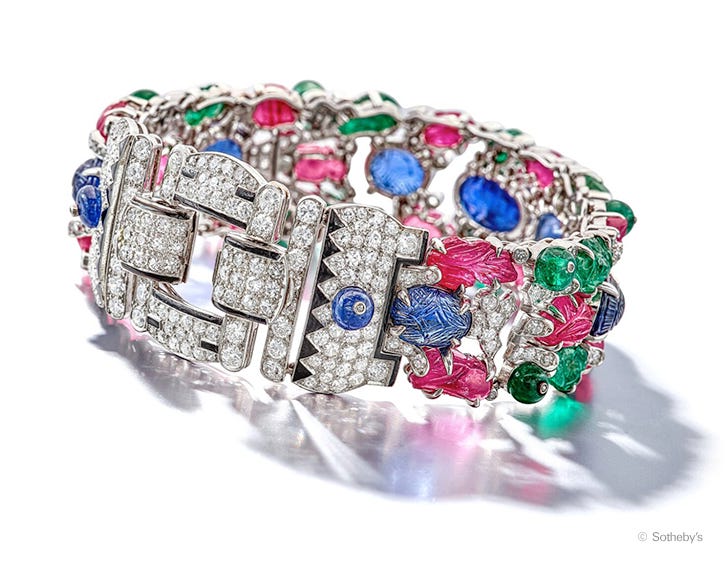
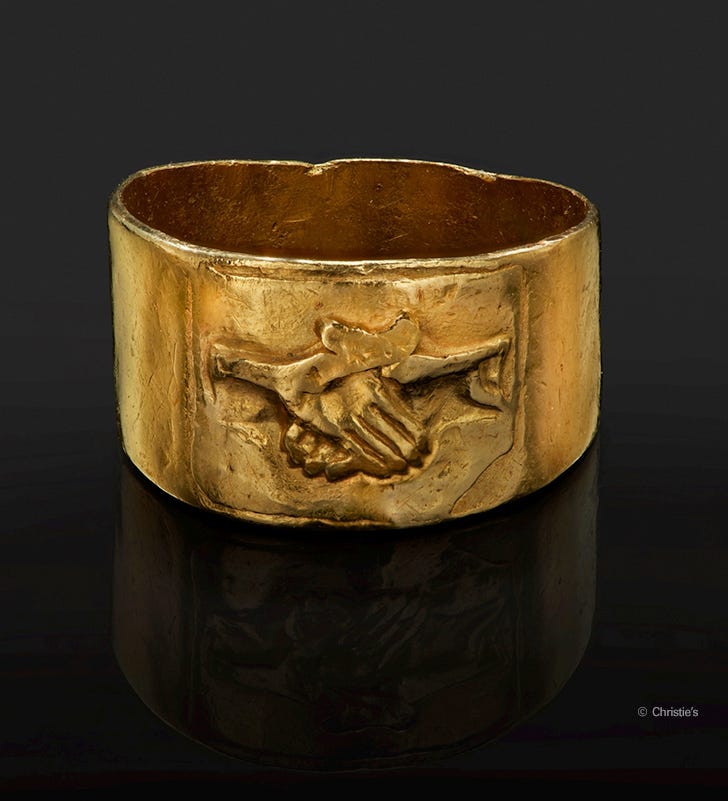
Thank you as always for another delightful issue of Dearest.
Beautiful and weird items to look at along with excellent (and sometimes very fun snarky!) comments.
I love your newsletter and can't wait for the October issue!
Take care and stay healthy.
The watch is, indeed, irritating in the extreme